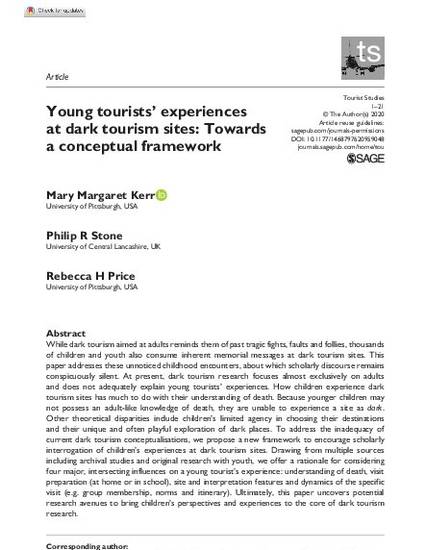
Article
Young tourists' experiences at dark tourism sites: Towards a conceptual framework
Tourist Studies
(2021)
Abstract
While dark tourism aimed at adults reminds them of past tragic fights, faults and follies, thousands
of children and youth also consume inherent memorial messages at dark tourism sites. This
paper addresses these unnoticed childhood encounters, about which scholarly discourse remains
conspicuously silent. At present, dark tourism research focuses almost exclusively on adults
and does not adequately explain young tourists’ experiences. How children experience dark
tourism sites has much to do with their understanding of death. Because younger children may
not possess an adult-like knowledge of death, they are unable to experience a site as dark.
Other theoretical disparities include children’s limited agency in choosing their destinations
and their unique and often playful exploration of dark places. To address the inadequacy of
current dark tourism conceptualisations, we propose a new framework to encourage scholarly
interrogation of children’s experiences at dark tourism sites. Drawing from multiple sources
including archival studies and original research with youth, we offer a rationale for considering
four major, intersecting influences on a young tourist’s experience: understanding of death, visit
preparation (at home or in school), site and interpretation features and dynamics of the specific
visit (e.g. group membership, norms and itinerary). Ultimately, this paper uncovers potential
research avenues to bring children’s perspectives and experiences to the core of dark tourism
research.
Keywords
- dark tourism,
- death,
- children,
- youth,
- experience,
- tourist
Disciplines
Publication Date
June, 2021
DOI
https://journals.sagepub.com/doi/10.1177/1468797620959048
Citation Information
Kerr, M., Stone, P.R., & Price R. (2021) Young tourists' experiences at dark tourism sites: Towards a conceptual framework. Tourist Studies, Vol 21, Issue 2, pp.198-212. https://journals.sagepub.com/doi/10.1177/1468797620959048
